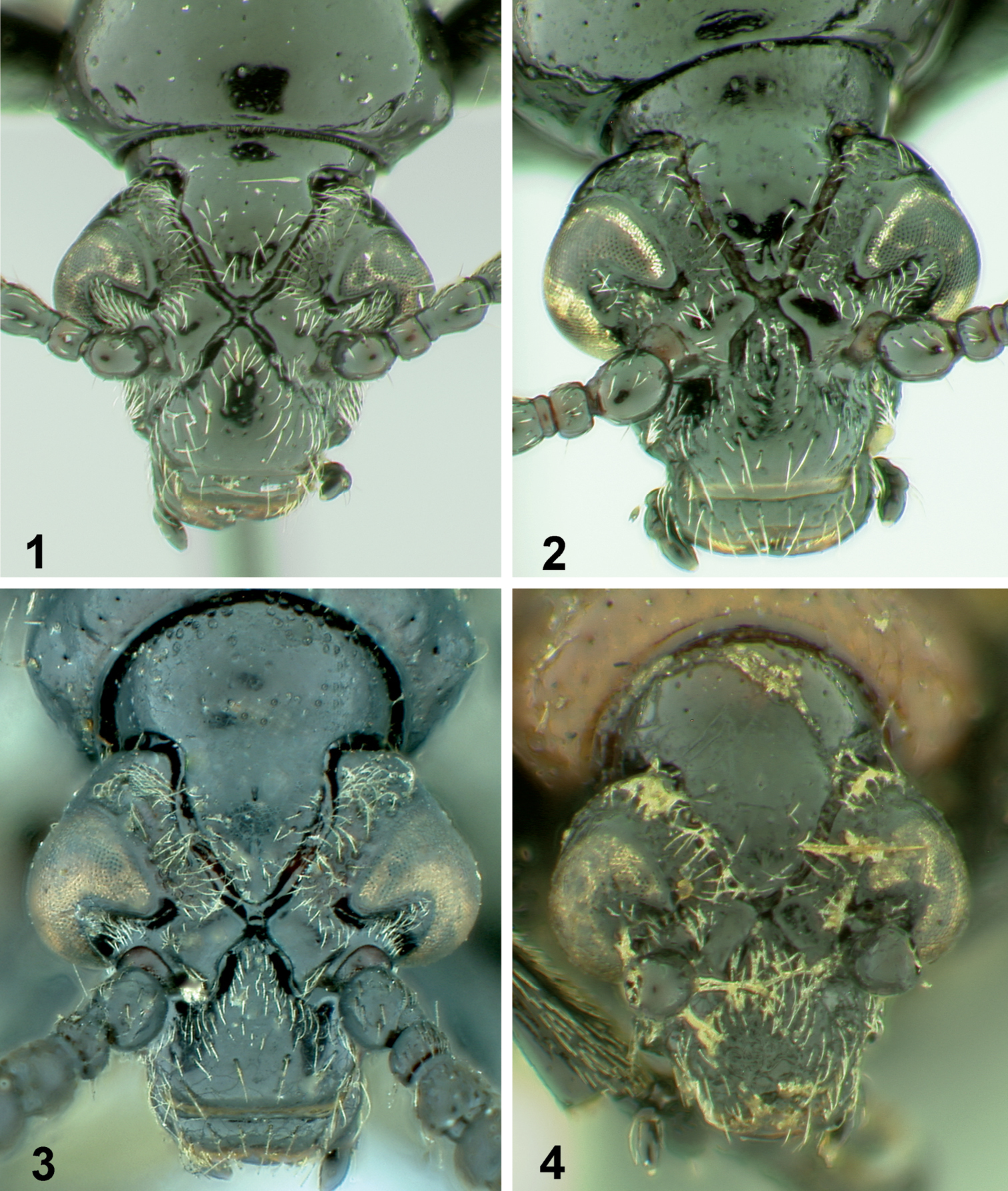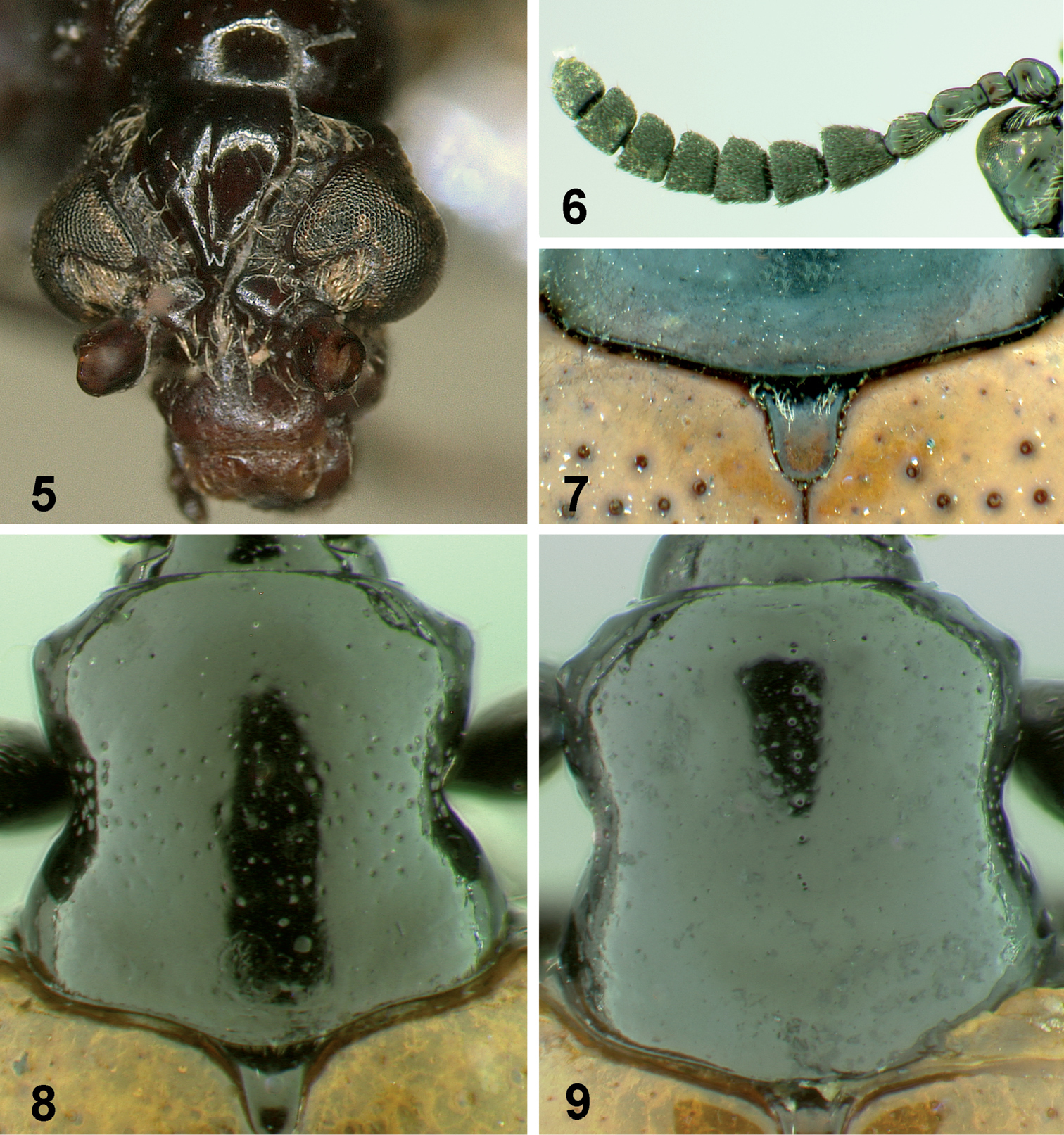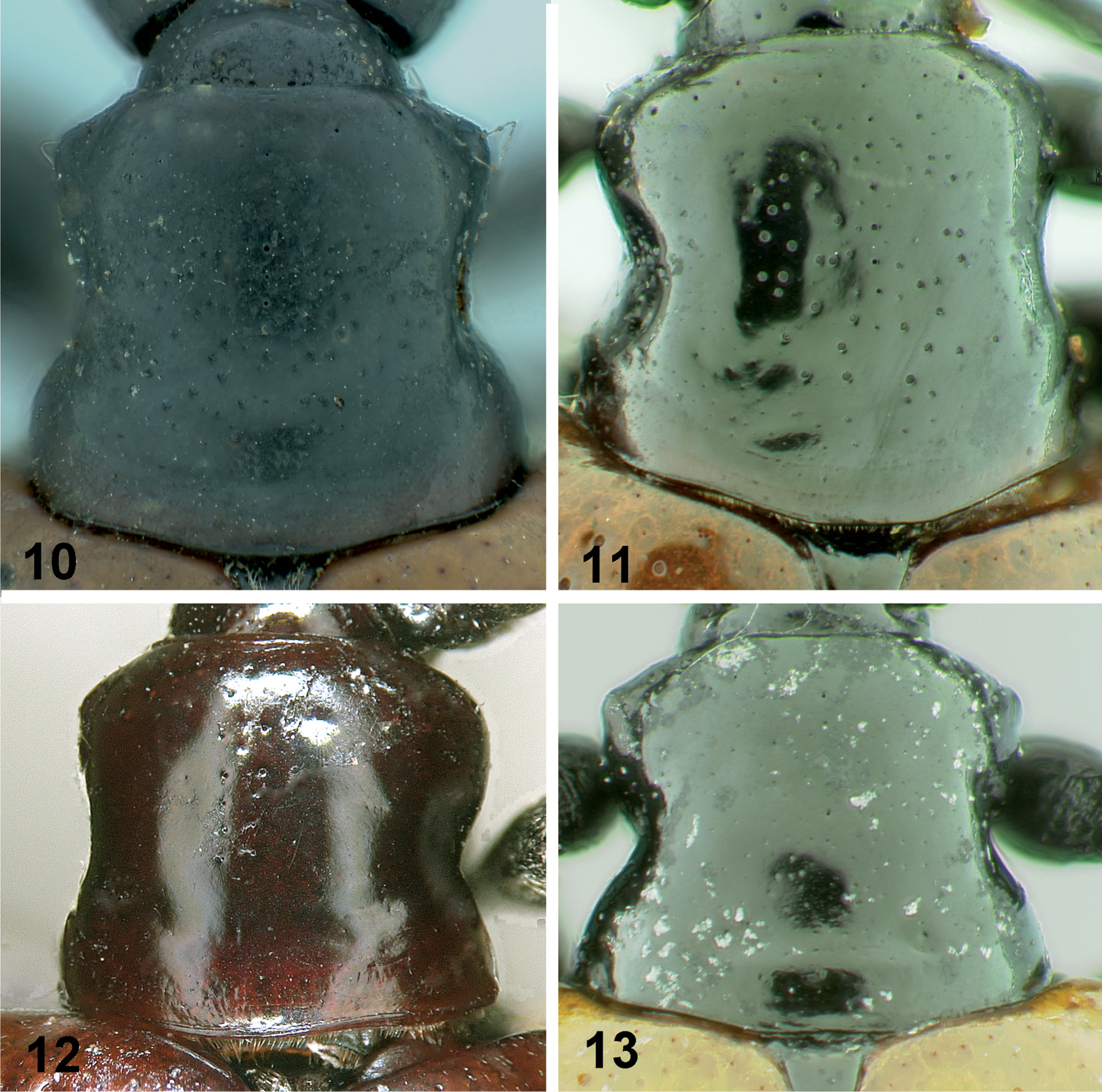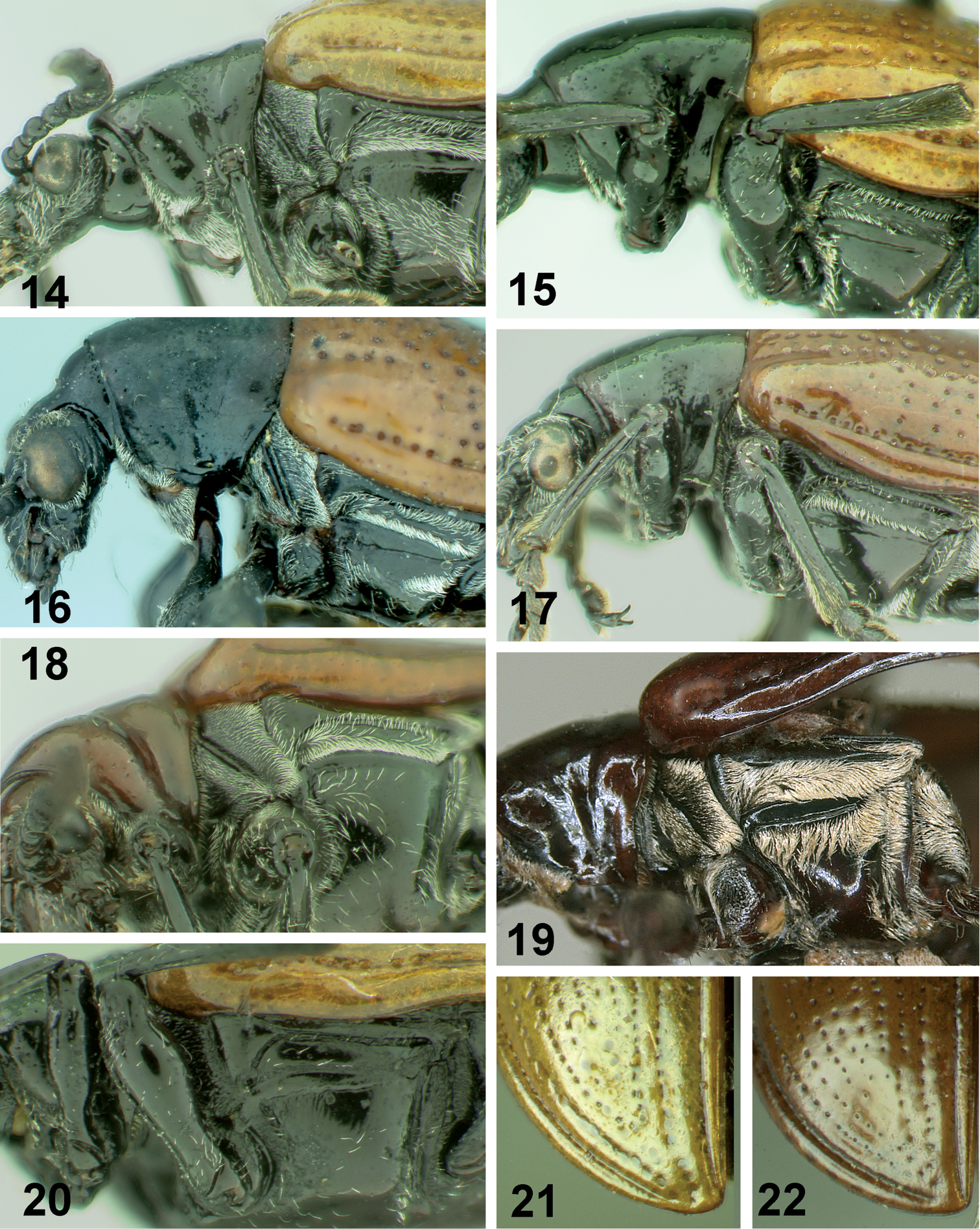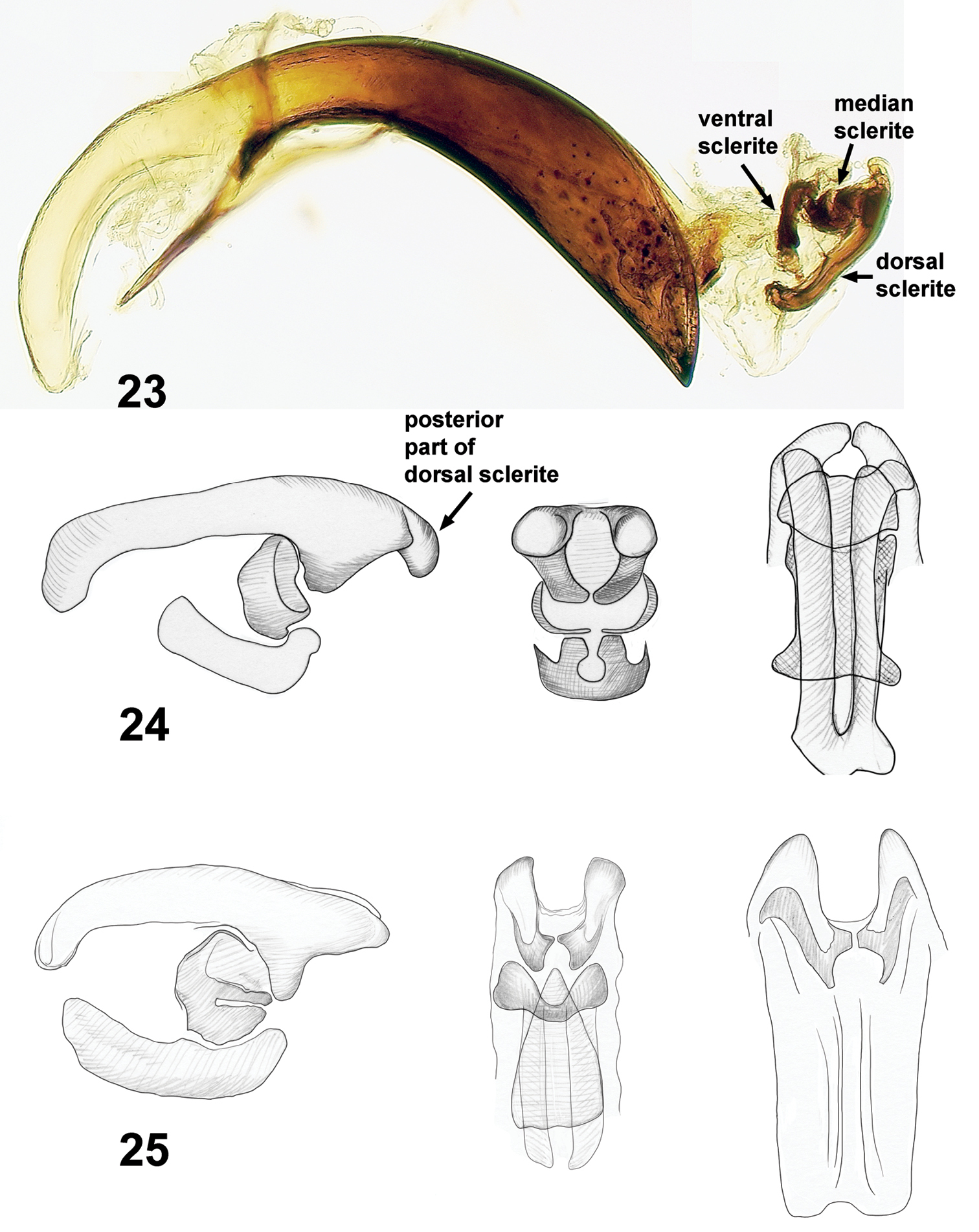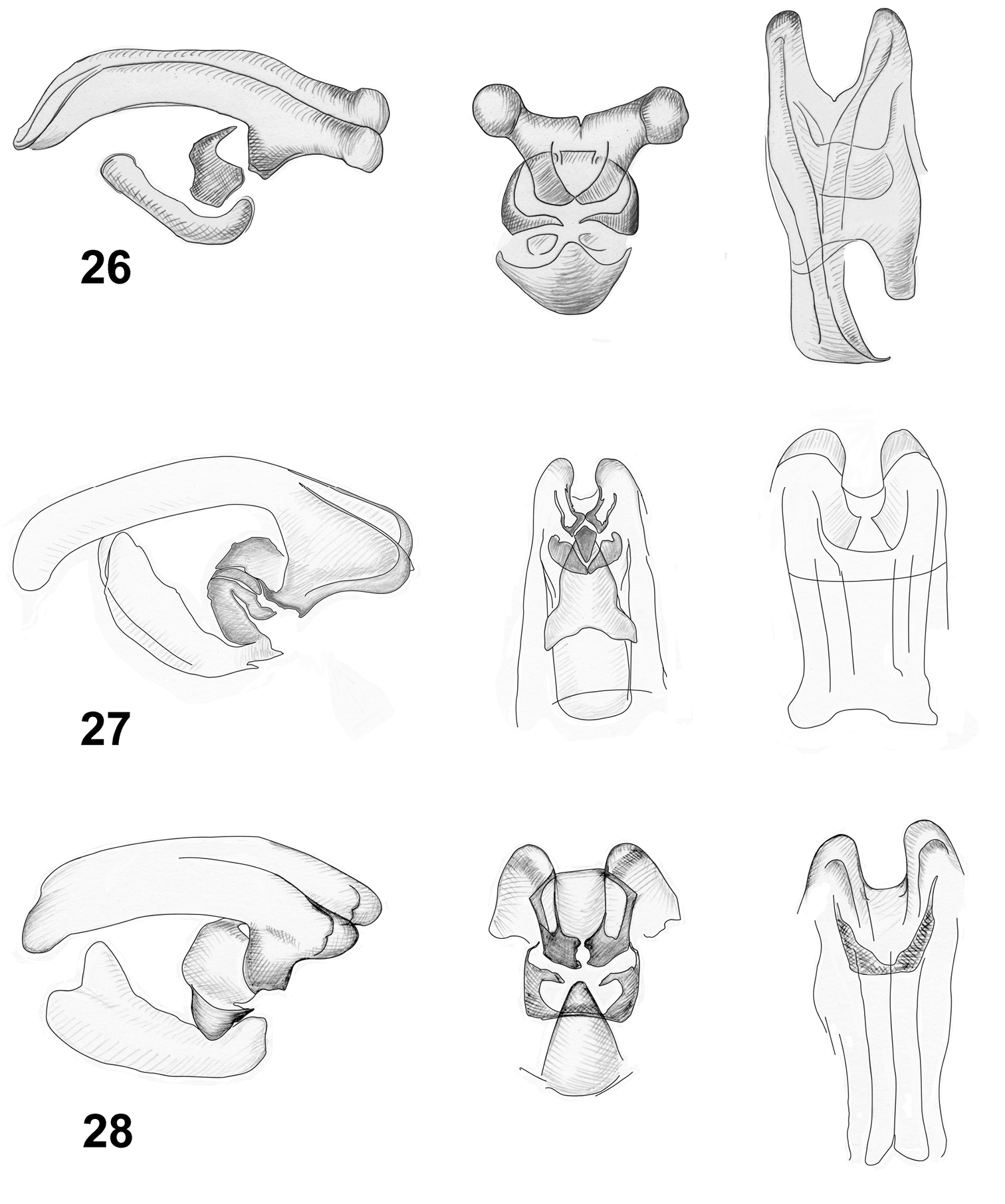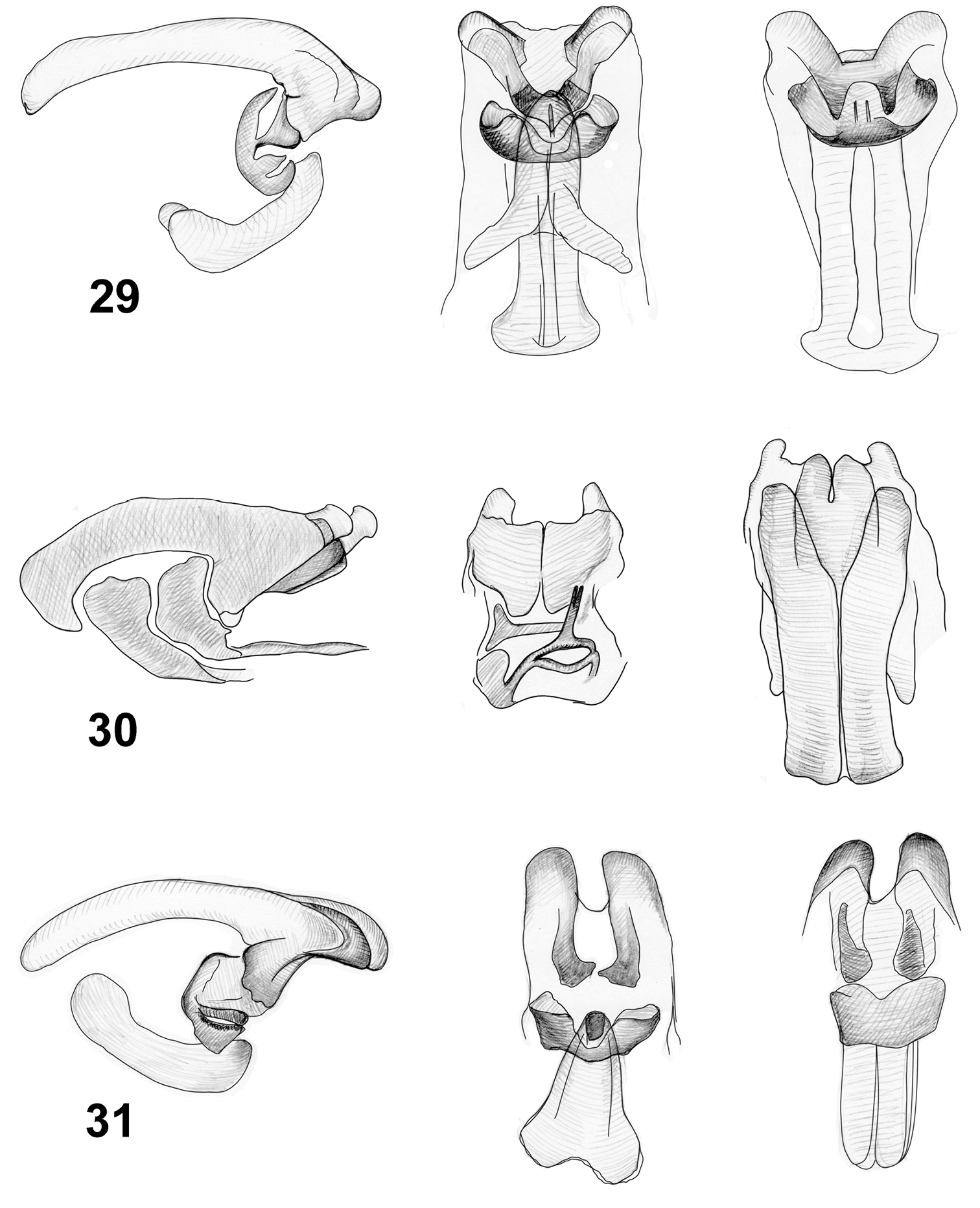






(C) 2011 Alexey K. Tishechkin. This is an open access article distributed under the terms of the Creative Commons Attribution License, which permits unrestricted use, distribution, and reproduction in any medium, provided the original author and source are credited.
For reference, use of the paginated PDF or printed version of this article is recommended.
Criocerine leaf beetles found in Nepal feeding on Dioscorea bulbifera (L.), an invasive weed of Asian origin, were identified as Lilioceris cheni Gressitt and Kimoto based on a synopsis of the Oriental Lilioceris species and review of the Lilioceris impressa species group. All the continental, Oriental species included in the group are diagnosed and illustrated, and a key for their identification is provided. Species status of Lilioceris thibetana Pic, 1916 is resurrected. The following new synonyms are proposed: Lilioceris coomani (Pic, 1928) = Lilioceris egena (Weise, 1922), and Lilioceris subcostata (Pic, 1921a), Lilioceris laticornis (Gressit, 1942), Lilioceris inflaticornis Gressit & Kimoto, 1961, and Lilioceris maai Gressit & Kimoto, 1961 = Lilioceris impressa (Fabricius, 1787). Lectotypes of the following species are designated: Lilioceris coomani Pic, 1928; Lilioceris impressa (Fabricius, 1787); Lilioceris laosensis (Pic, 1916); Lilioceris malabarica (Jacoby, 1904); Lilioceris ruficornis (Pic, 1921b); Lilioceris subcostata (Pic, 1921a); Lilioceris thibetana (Pic, 1916); and Lilioceris unicolor (Hope, 1831).
Coleoptera, Chrysomelidae, Criocerinae, Lilioceris, key, Oriental Region, new synonyms, Dioscorea bulbifera, air potato, biology, Lilioceris cheni
This study was initiated by the need to identify leaf beetles that were feeding on Dioscorea bulbifera L.(Dioscoreaceae) in Nepal. Dioscorea bulbifera
(air potato) is a herbaceous, perennial twining vine that attains
lengths of 20 m or more, rendering it capable of climbing over and
smothering native vegetation (e.g.,
Leaf beetles that were found feeding on air potato in Nepal were not identifiable to species using existing keys (
Specimen observation and preparation follow the methods of
BBM Bernice Bishop Museum, Honolulu, HI
BMNH The Natural History Museum London, United Kingdom
CAS California Academy of Sciences, San Francisco, CA
HUB Museum für Naturkunde, Berlin, Germany
MNHN Muséum National d’Histoire Natural, Paris, France
UCD Zoological Museum, University of Copenhagen, Copenhagen, Denmark
USNM National Museum of Natural History, Smithsonian Institution, Washington, DC
ZMUH Zoologisches Intsitute und Zoologisches Museum, Universität Hamburg, Hamburg, Germany
The most reliable characters for discrimination of Lilioceris species are those of the internal sac of the aedeagus. In Criocerinae, these characters were used previously for separation of Lilioceris species from Iran (
Dissection and preparation of the sclerites of the internal sac of the aedeagus are relatively simple. We used slightly bent #1 entomological pins to extract the internal sac from the dorsal opening of the aedeagus that was soaked in hot 10% KOH solution for 15–20 minutes and washed in excess of water. Figures were generated using a Camera Lucida attached to a Zeiss Stemi SV 11 dissecting microscope. They were scanned and edited with Adobe Photoshop.
Systematics of Lilioceris impressa species groupSpecies of the Lilioceris impressa group share the following characters: 1) glabrous scutellum almost completely lacking setae, with only a few setae occasionally present near the base (Fig. 7); 2) antennomeres 5–10 distinctly flattened, quadrate or even transverse (antennomere 5 often slightly elongate) and covered with dense, short, appressed setae (in clear contrast with more basal antennomeres bearing longer, more erect and much sparser setae, not obscuring the view of glabrous cuticle) (Fig. 6); and 3) structure of the sclerites of the internal sac of the aedeagus. The dorsal and ventral sclerites are roughly plank-like in shape, the dorsal one being longer and more complex shaped, especially anteriorly where it bears two relatively long lateral processes that vary in shape.
To a lesser extent color (traditionally often used in distinguishing and keying out Lilioceris species) is helpful to recognize representatives of the species group. Typically, they have a black head, thorax, abdomen and legs, and brownish-yellow to reddish elytra. Black legs and pale unspotted elytra are consistent throughout all species group members, while the head and thorax may be partially or entirely brown, reddish-brown or reddish; these paler colors are variably present around the abdominal apex.
The three characters mentioned above, in combination, define the group. As to the similar species, there are, on one hand, several similar looking black and red (yellow) species with a glabrous scutellum and similar structure of male genitalia, which have distinctly, often substantially elongate (never close to quadrate or transverse) antennomeres 5–10. On the other hand, a group of mostly entirely reddish species with the antennal characters identical to those of the impressa-group possess consistently a completely setose scutellum and differently shaped sclerites of the aedeagal internal sac (in particular, the dorsal sclerite is narrow, elongate and thread-like, at least apically). A few species with consistently spotted elytra (e.g., Lilioceris bakewelli Baly, Lilioceris ruficollis Baly) possess all of the characters in agreement with the impressa-group as it is outlined above.
Below, we are introducing several new synonymies and
rearranging several previously proposed synonyms. There are two primary
reasons for these changes in taxonomy of the Oriental Lilioceris.
First, in the course of this study we introduced for the first time
the use of male genitalia characters into the diagnostics of the
species, in particular focusing on the sclerites of the internal sac of
the aedeagus. In general, male genitalia morphology in the Oriental
species appeared to be quite conservative. However, minor differences
in the shape of the aedeagus and characters of the aedeagal sclerites of
the internal sac are stable and consistent across vast species ranges
and among multiple individuals within populations. This consistent set
of aedeagal characters provides reliable diagnostics among species that
are otherwise monotonous with respect to color and punctation. As a
result, some misidentifications were corrected and species identities
clarified. Second, the accepted concept of Lilioceris impressa (
| 1 | Outer parts of metasternal disc mostly free of setae; isolated latero-posterior setose patches or lateral extensions of anterior setose margins present in some species and widely scattered single setae may present on unworn individuals | 3 |
| - | Outer parts of metasternal disc or its lateral side mostly covered with dense setae; other characters variable | 2 |
| 2 | Internal sac of aedeagus with posterior part of dorsal sclerite in lateral view directed ventrally | Lilioceris cheni Gressit & Kimoto |
| – | Internal sac of aedeagus with posterior part of dorsal sclerite in lateral view directed dorsally | Lilioceris unicolor Hope |
| 3 | Outer parts of metasternal disc without isolated posterior setose patches | 4 |
| – | Outer parts of metasternal disc with isolated posterior setose patches; pronotum with scattered large punctures, elytral punctures not weakened posteriorly, elytral interval in pre-apical area distinctly convex | Lilioceris impressa (Fabricius) |
| 4 | Pronotal disc completely covered with scattered large punctures | 5 |
| – | Large punctures on pronotal disc present only as a row along mid-line, at least on anterior half, the rest of the disc utmost with only some tiny punctures | 6 |
| 5 | Elytral punctures on posterior third not weakened, more or less the same size and depth as on anterior half; pronotum posteriorly with single weak, regularly transverse impression; posterior part of dorsal sclerite of aedeagus in dorsal view directed laterally (Fig. 29) | Lilioceris thibetana (Pic) |
| – | Elytral punctures on posterior third variably, but distinctly, weakened; pronotum posteriorly with two weak, but distinct transverse irregular impressions; posterior part of dorsal sclerite of aedeagus in dorsal view directed medially (Fig. 27) | Lilioceris laosensis (Pic) |
| 6 | Occipital area with shallow furrow sometimes reduced to deep small fovea at midpoint; elytral intervals in preapical area flat | 7 |
| – | Occipital area without longitudinal furrow, only with weak impression and thin, indistinct suture; elytral intervals in preapical area distinctly convex | Lilioceris egena (Weise) |
| 7 | Anterior setose fringe of metasternum expanded on antero-lateral corner; lateral side of pronotum around constriction impunctate; most of metepisternal disc densely covered with setae | Lilioceris malabarica (Jacoby) |
| – | Anterior setose fringe of metasternum narrow, not expanded; lateral side of pronotum around constriction with several large punctures; setae on metepisternal disc present only as narrow strip along inner margin | Lilioceris yunnana (Weise) |
http://species-id.net/wiki/Lilioceris_cheni
Figs 1, 6, 8, 14, 21, 23, 24Occipital area with a shallow furrow, at least with a deep small fovea at mid-point. Apical elytral punctures strong. Pronotal disc with scattered larger punctures, mid-line alignment of punctures usually evident, at least in anterior half. Pronotum posteriorly with single weak, irregular, variable, transverse impression. Lateral sides of pronotum around constriction with large punctures. Outer metasternal disc almost completely covered with setae. At least half of metepisternal disc covered with setae. Apical elytral intervals distinctly raised. Internal sac of aedeagus with posterior part of dorsal sclerite in dorsal view more or less parallel-sided, directed medially. Posterior part of dorsal sclerite in lateral view more or less parallel-sided, bent ventrally, directed ventrally.
The holotype of Lilioceris cheni is housed in the Bishop museum collection. This collection contains 5 more specimens of this species all identified as Lilioceris cheni by Kimoto in 1967 and 1977, none of them are marked as paratype.
Pale white, oblong eggs of Lilioceris cheni are deposited in loosely aggregated clusters on leaves of its host plant, Dioscorea bulbifera (air potato: Dioscoreaceae). Females deposit, on average, more than 1200 eggs during their lifetime. The eggs become yellowish as the embryo develops and dark reddish eye spots appear mid-way through the incubation period. The entire incubation period requires about 4 days. The larvae are yellowish at first, becoming grayish in later instars, with black legs, head capsule, and prothoracic shield. They are often covered with a slimy substance to which fecal material adheres. Larvae feed gregariously and skeletonize the leaves from the underside. Young leaves are preferred but they also consume older, tougher leaves and are able to feed on the aerial bulbils. Complete development of the four larval instars requires about 8 days, with each instar lasting about 2 days each. When fully grown, larvae drop from the host plant to the soil which they quickly enter. They then produce a whitish oral exudate that hardens into a foam-like cocoon. Pupation often occurs gregariously, with several pupae clumped together within a matrix of this material. Adults emerge in about 16 days, begin mating in about 10 days following emergence, and initiate oviposition about 5 days later. The adults live 3 months or more and can survive a month without food.
In the Katmandu Valley of Nepal, the host plant drops its leaves during the cool, dry winter forcing the adult beetles to over-winter beneath debris on the ground. The adults emerge during mid-May to early June. Oviposition begins during late May and continues till mid-June. Females lay about 90 eggs/day during a 13-day period of ovipositional activity. Overwintered adult beetles live until mid-July, for about 76 days after emergence.
Lilioceris cheni: Holotype male: 1) Fukien, S. China, Shaowu city to Kaoyang, T. C. Maa Coll.; 2) July 30, 1945; 3) Holotype Lilioceris cheni J. L. Gressitt + K.; 4) L. cheni sp. n. Det. S. Kimoto (BBM).
CHINA. Yunnan: Ma-Chang, 1000 m, 1 specimen (USNM); Tche-Ping-Tcheou, 1 specimen (USNM); 13–18.X.2010, RCVDIPRL 25. Oct. 10, M. Percell (USNM). INDIA. Indie orientales, 1 specimen (USNM). Assam: Chabua, 8.V.1944, G. Butler, 1 specimen (USNM). LAOS. Sayaboury Prov., Sayabouri, 30.V.1965, native collector, 1 specimen (BBM); Vientianne Prov., Vientianne, 21.IV.1965, J. A. Rondon, 1 specimen (BBM). NEPAL. On road to Dhunche, 5 km SW Ranipawa, 27°48.92'N, 85°13.41'E, 1700 m, 28.IV.2000, A. Konstantinov, S. Lingafelter & M. Volkovitch, 1 specimen (USNM); Gairigaonbelow Nagarkot, Kathmandu Valley, host Dioscorea bulbifera, 27.VIII.2002, Pemberton & Rayamhji, 1 specimen (USNM); Env.ofKathmandu, Palchoki Mount, 27°34.65'N, 85°24.04'E, 2300–2730 m, sweeping, 14.V.2000, A. Konstantinov, S. Lingafelter & M. Volkovitch, 1 specimen (USNM); Lalitpur, Kathmandu, 4.VIII.-15.X.2007, Yukawa & Junichi, 29 specimens (USNM); Seutikhola Dharan road, Sunsan, host Dioscorea bulbifera, 4.IX.2002, Pemberton & Rayamhji, 1 specimen (USNM); Tarai Reg., Narayangarh, along Rapti River, 27°42.31'N, 84°21.11'E, beating, 26.IV.2000, A. Konstantinov, S. Lingafelter & M. Volkovitch, 1 specimen (USNM).
Heads of Lilioceris species, frontal view. 1 Lilioceris cheni 2 Lilioceris egena 3 Lilioceris impressa 4 Lilioceris thibetana.
http://species-id.net/wiki/Lilioceris_egena
Figs 2, 9, 15, 25Occipital area without longitudinal furrow. Pronotal disc without or with few small punctures, larger punctures present only along pronotal mid-line at least in anterior half. Lateral sides of pronotum around constriction with large punctures. At least half of metepisternal disc covered with setae. Outer metasternal disc mostly free of setae. Anterior setose fringes not expanded in antero-lateral corners.
Apical elytral punctures strong. Apical elytral intervals distinctly raised. Internal sac of aedeagus with posterior part of dorsal sclerite in dorsal view more or less triangular, directed forward. Posterior part of dorsal sclerite in lateral view more or less triangular, directed forward.
We were not able to find type material for this species. The type specimens were not found in Berlin (HUB) nor in Hamburg (ZMUH) (Peters, personal communication, August-September 2009). There is a strong possibility that the types were destroyed in Hamburg during World War II. However, two specimens identified as Lilioceris egena by J. Weise himself (including a male) were available for the study, and we based our concept of the species on these specimens. However, we are reluctant to designate the neotype at this moment, since an exhaustive search in other potential depositories has not been undertaken during the preparation of this manuscript. The male holotype of Lilioceris coomani perfectly corresponds to males of Lilioceris egena as we understand it now. This species is collected feeding on Dioscorea subclava Prain & Burkill in China.
Lilioceris coomani:Lectotype male [dissected on mounting cardboard] 1) [illegible] concave glabre; 2) 785 Crioceris sp.; 3) type; 4) TYPE; 5) coomani n sp; 6)Lectotype Lilioceris coomaniPic A. Tishechkin & A. Konstantinov des. 2010 (MNHN); paralectotype female on the same pin with “156” written on mounting cardboard; paralectotype designation label put on the same pin.
CHINA. Kiang Li, Tengan, 2 specimens (USNM). Anhui: Taipingshien, X.1932, G. Liu, 1 specimen (USNM); Yunnan, Dali City, 20.VIII.2010 (USNM). Fujian: Shaowu, Shui Pei Kai, T.C. Maa, 1 specimen (BBM); same locality and collector, but 25.III.1942, 1 specimen (USNM); without precise locality, G. Siemssen, 4.IX.1913, 2 specimens identified by J. Weise (USNM); with the same label, but 1.IV.1914, 1 specimen (USNM). Hong Kong: May 6 1940, P. K. To (1 BBM); Circa 1, 600 ft, 24.IX.1937, Miss Harford. B.M. 1938-426 (1 BBM). Kieniyang Liutuan, T. C. Maa, 22.VIII.1942 (1 BBM). Sichuan: Shin Kai, 4400 feet, VIII.1922, D. C. Graham, 1 specimen (USNM); Wen-ch’uan, 4000–6000 feet, VII.1938, D. C. Graham, 1 specimen (USNM). INDIA. Assam: Darjeeling (Himalayas), 1 specimen (USNM). Karnataka: Mysore, 2 specimens (USNM). Uttarhand: Dehra Dun, 600 m, 18.VII.1973, G. Ekis, 2 specimens (USNM); 3 km NW Rishikesh, 10.V.1975, J. L. Petty, 1 specimen (USNM). LAOS. Vientianne Prov., Ban Van Eue, 1–15.IX.1967, native collector, 1 specimen (BBM); Phou-kow-kuei N of Vientianne, 17.IV.1965, J. L. Gressit, 1 specimen (BBM). NEPAL. Env.of Kathmandu, Bonipa, 27º40’N, 85º25’E, 8.V.2000, A. Konstantinov, S. Lingafelter & M. Volkovitch, 1 specimen (USNM); Jiri-Kathmandu road, high pass between Sikri and Kabre (Mudee), 27º42’7”N, 85º56’24”E, 2632 m, V.2000, A. Konstantinov, S. Lingafelter & M. Volkovitch, 1 specimen (USNM); Tarai, env. Chitwan Park, 27º28.79’N, 84º52.54’E, 300 m, 25.IV.2000, beating, A. Konstantinov, S. Lingafelter & M. Volkovitch, 1 specimen (USNM); Tarai Reg., Narayangarh, along Rapti River, 27º42.31’N, 84º21.11’E, beating, 26.IV.2000, A. Konstantinov, S. Lingafelter & M. Volkovitch, 1 specimen (USNM). SINGAPORE. Without precise location, Coll. Baker, 19 specimens (USNM). VIETNAM. Saigon, 1 specimen (USNM); Trang Bom, 30 mi NW of Saigon, 18.VII.1932, M. Poilane, 1 specimen (USNM).
Body parts of Lilioceris species. 5 head of Lilioceris unicolor, frontal view 6 antenna of Lilioceris cheni 7 scutellum of Lilioceris impressa; 8–9 pronotum 8 Lilioceris cheni 9 Lilioceris egena.
http://species-id.net/wiki/Lilioceris_impressa
Figs 3, 7, 10, 16, 26Occipital area with shallow furrow, at least with deep small fovea at midpoint. Pronotum posteriorly with single weak, regular, transverse impression. Pronotal disc with scattered larger punctures, mid-line alignment of punctures usually still evident, at least on anterior half. Lateral side of pronotum around constriction with large punctures. Outer metasternal disc only with oblique setose patch. Anterior setose fringe not expanded in antero-lateral corner. At least half of metepisternal disc covered with setae. Apical elytral punctures strong. Apical elytral intervals distinctly raised. Internal sac of aedeagus with posterior part of dorsal sclerite in dorsal view elongate, narrowing posteriorly, directed slightly laterally. Posterior part of dorsal sclerite in lateral view widening and round at apex, directed forward.
All five species put here into synonymy with Lilioceris impressa
correspond to it well. There is slight variability in the size of the
outer metasternal setose patch, and color varies from almost completely
reddish-brown to typical black and yellow, but pronotal and elytral
punctuation and sculpture as well as aedeagus characters are consistent
between specimens. We did not observe any meaningful variability in the
shape of the expanded distal antennomeres, which was used by Gressit
and Kimoto in describing Lilioceris inflaticornis and Lilioceris laticornis. However, even these authors had some doubts about the use of these characters, even in the reference to the type series (
We did not thoroughly search for Lilioceris impressa-group specimens originating from outside of the area of interest, in particular from the islands and archipelagoes of the Oriental Region. However, all the island specimens in the USNM identified as Lilioceris impressa do not belong to this species and all lack the outer metasternal setose patch. So, the prevailing concept of Lilioceris impressa, being widely distributed across almost the entire Oriental Region, seems to be at least questionable. All the USNM Lilioceris impressa-group specimens originating from Sri Lanka, Andaman Islands, Greater and Lesser Sunda Islands, and Philippines were not identified as any of the species dealt with in this study and might indeed represent undescribed species closely related to other Lilioceris impressa-group species.
Lilioceris impressa: Lectotype, male. Labels. 1) Cr. impressa Fabr. Mant. Ind. n. 24; 2) Sir Joseph Banks Collection 1743–1820 ex. Linn. Soc. 1863 BM(NH) 1863-46; 3) ‘Type’ Crioceris impressa Fab. 1787; 4) Lectotype Crioceris impressa Fabricius des Konstantinov and Tishechkin 2010 (BMNH).
Lilioceris inflaticornis: Paratype, male, Fujian: Gang-keu, 26.VII.1936, J. L. Gressitt, 1 male (BBM).
Lilioceris laticornis: Paratype, Hainan: nr. Nodoa, Tan-hsien (Distr.), 17–22.VIII.1928, Lingnan Univ. 5th Hainan Island Expedition, 1 female (USNM).
Lilioceris maai: Holotype male: 1) Fukien S. China, Shaowun Tachulan 1000 m. T. Maa; 2) May 7, 1942; 3) Holotype Lilioceris maai J. L. Gressitt + Kim; 4) Lilioceris maai Gres. Kim. J. L. Gressitt det.; 5) Lilioceris sp. 1 maai; 6) Lilioceris impressa (F.) det. A. Konstantinov 2010. (BBM). Paratypes CHINA. Fujian: Shaowu, Tachulan, 26.IV.1942, T.C. Maa, 2 females (BBM), same locality and collector, but 1000m, 7.6.1943 female (BBM); same locality and collector, but 17.V.1942, 1 female (USNM); same locality, but 17.V.1945, K. C. Lin, 1 female (BBM).
Lilioceris ruficornis, Lectotype, female. Labels. 1)“Pe yen Tsing Yunnan; 2) type; 3) TYPE; 4) ruficornis n sp; 5) Lectotype Crioceris ruficollis Pic des Konstantinov and Tishechkin 2010 (MNHN).
Lilioceris subcostata, Lectotype, male. Labels. 1) Shin-Guy-Foo CHINE ; 2) octobre; 3) n sp; 4) type; 5) TYPE; 6) subcostata n sp; 7) Lectotype Crioceris subcostata Pic des Konstantinov and Tishechkin 2010 (MNHN).
CHINA. Hainan: Dwa Bi, 20.VII. 1935, L. Gressitt, identified as Lilioceris laticornis by S. Kimoto, 1959, 1 female (BBM); same locality, but 22.VII.1935 (1 BBM); Pan Heang 8.VI.1935, L. Gressitt (1 BBM). Sichuan: between Yachow and Kiating, 19–22.VI.1929, 1200–1500 feet, D. C. Graham, 1 specimen (USNM). Yunnan: Pe Yen Tsing, 1 specimen (USNM); Tche-Ping-Tcheou, 8 specimens (USNM); no precise locality, 1 specimen (USNM). INDIA. Haryana: Kalka, 1 specimen (USNM). LAOS. Sayaboury Prov. Sayaboury 30.V.1065, (1 BBM); Khammouane Prov. Phon Tiou, 6.VII.1965 (3 BBM). MALAYSIA. Malacca, 1 specimen (USNM). THAILAND. Trong, lower Siam, W. L. Abbott, 2 specimens (USNM). VIETNAM. Hanoi, 24.XII.1961, at lights, O. N. Kabakov, 1 specimen (USNM); Trang Bom, 30 mi NW of Saigon, 18.VII.1932, M. Poilane, 1 specimen (USNM); same locality and collector, but 26.VII.1932, 1 specimen (USNM); Nord Annam, Than-Hoa, V.1942, R. Dessom, 1 specimen (USNM); mountains 50 km NE Thai Nguen, 300 m, 13.IX.1962, O. N. Kabakov, 1 specimen (USNM).
Pronotums of Lilioceris species, dorsal view. 10 Lilioceris impressa 11 Lilioceris laosensis 12 Lilioceris unicolor 13 Lilioceris yunnana.
http://species-id.net/wiki/Lilioceris_laosensis
Figs 11, 17, 22, 27Occipital area with a shallow furrow, at least with a deep small fovea at midpoint. Pronotum posteriorly with two weak, but distinct transverse irregular impressions. Pronotal disc with larger, scattered punctures, mid-line alignment of punctures usually still evident, at least in anterior half. Lateral sides of pronotum around constriction with large punctures. Outer metasternal disc mostly free of setae. Anterior setose fringes not expanded in antero-lateral corners. At least half of metepisternal disc covered with setae.
Apical elytral punctures weakened. Apical elytral intervals not raised. Internal sac of aedeagus with posterior part of dorsal sclerite in dorsal view more or less widely triangular, directed slightly medially. Posterior part of dorsal sclerite in lateral view more or less widely triangular, directed forward.
Lilioceris laosensis: Lectotype, male. Labels: 1) TAKEK LAOS COLL. LE MOULT; 2) [illegible] roux; 2) type; 3) TYPE; 4) laosensis Pic; 5)Lectotype Lilioceris laosensis Pic A. Tishechkin & A. Konstantinov des. 2010” (MNHN); paralectotype, male, the same labels as lectotype (MNHN).
CHINA. Fujian: near Foochow, 1921, C. R. Kellogg, 1 specimen (USNM); Yunnan: Ma-Chang, 1000 m, 1 specimen (USNM); Tche-Ping-Tcheou, 1 specimen (USNM). INDIA. Inde or, 1 specimen (USNM). Assam: Chabua, 8.V.1944, G. Butler, 4 specimens (USNM); Doom Dooma, VI.1943, D. E. Hardy, 1 specimen (USNM). Karnataka: Malabar, 1 specimen (USNM); Western Ghats, 7 km N Chickmagular, 13º23’23”N, 75º42’9”E, 1800 m, 15.XI.2003, A. Konstantinov, K. Prathapan & S. Saluk, 1 specimen (USNM). Sikkim: Rungbong Vall., Gopaldhara, 1916, H. Stevens, 1 specimen (MNHN); without precise locality, IX.1957, G. W. Angalet, 1 specimen (USNM). LAOS. Borikhane Prov. Pakkading 29.IV.1966 (1 BBM). MYANMAR. Carin Cheba, 1000 m, V.1888, L. Fea, 2 specimens (USNM); Tenasserim, Meetan, IV.1887, L. Fea, 1 specimen (USNM). NEPAL. Jiri Reg., Shivalaya-Jiri, 27º36.61’N, 86º17.55’E, 1770–1900 m, pass, 2200m, 12.V.2000, A. Konstantinov, S. Lingafelter & M. Volkovitch, 1 specimen (USNM); Sankhua Sabha Dist., Arun Valley, Chichila, 1900–2000 m, 18–20.VI.1988, J. Martens & W. Schawaller, 1 specimen (USNM). THAILAND. Doi Sutep, 26.VIII.1951, 1 specimen (USNM); Trong, lower Siam, W. L. Abbott, 4 specimens (USNM). VIETNAM. Bao Lac (Tonkin), 2 specimens (USNM); Nord Annam, Than-Hoa, V.1942, R. Dessom, 1 specimen (USNM); Trang Bom, 30 mi NW of Saigon, 23.VII.1932, M. Poilane, 1 specimen (USNM).
Thorax of Lilioceris species, 14–20 lateral view; 21, 22 elytral apex. 14 Lilioceris cheni 15 Lilioceris egena 16 Lilioceris impressa 17 Lilioceris laosensis 18 Lilioceris malabarica 19 Lilioceris unicolor 20 Lilioceris yunnana 21 Lilioceris cheni 22 Lilioceris laosensis.
http://species-id.net/wiki/Lilioceris_malabarica
Figs 18, 28Occipital area with a shallow furrow, at least with a deep small fovea at midpoint. Pronotum posteriorly with single weak, regular, transverse impression. Pronotal disc without or with few small punctures, larger punctures present only along pronotal mid-line, at least in anterior half. Lateral sides of pronotum around constriction impunctate. Outer metasternal disc mostly free of setae. Anterior setose fringes expanded in antero-lateral corners. At least half of metepisternal disc covered with setae. Apical elytral punctures weakened. Apical elytral intervals not raised. Internal sac of aedeagus with posterior part of dorsal sclerite in dorsal view more or less widely triangular, directed forward. Posterior part of dorsal sclerite in lateral view more or less widely triangular, directed forward.
Lilioceris malabarica: Lectotype, male. Labels: 1) Type H.T.; 2) 432; 3) Mahe Malabar; 4) Jacoby Coll. 1909-28a; 5) Crioceris malabarica Jac.; 6) Lectotype Lilioceris malabarica (Jacoby), des. Konstantinov and Tishechkin 2010 (BMNH). Paralectotype, female, same label as lectotype (BMNH). Paralectotype, male. Labels: 1) Nilgiri Hills; 2) 810; 3) Crioceris semipunctata Fab.; 4) Crioceris malabarica HEA Jac; 5) Andrewes Bequest B.M. 1922-221; 6) Paralectotype Lilioceris malabarica (Jacoby), des. Konstantinov and Tishechkin 2010 (BMNH).
INDIA. Kerala: Mahé, Malabar, 1 specimen (USNM); Malabar, gift of F. C. Bowditch, 4 specimens (USNM).
Aedeagi of Lilioceris species, 23 aedeagus in lateral view with internal sac everted 24–25 sclerites of internal sac. 23, 24 Lilioceris cheni (lateral, frontal and dorsal views) 25 Lilioceris egena (lateral, frontal and dorsal views).
http://species-id.net/wiki/Lilioceris_thibetana
Figs 4, 29Occipital area with a deep small fovea at midpoint. Pronotum posteriorly with single weak, regular, transverse impression. Lateral sides of pronotum around constriction with large punctures. Pronotal disc with scattered larger punctures, mid-line alignment of punctures usually still evident, at least in anterior half. Outer metasternal disc mostly free of setae. Anterior setose fringes not expanded in antero-lateral corners. About half of metepisternal disc covered with setae. Apical elytral punctures strong. Apical elytral intervals not raised. Internal sac of aedeagus with posterior part of dorsal sclerite in dorsal view very short, widely rounded, directed laterally. Posterior part of dorsal sclerite in lateral view very short, widely rounded, directed forward.
Lilioceris thibetana: Lectotype, male. Labels: 1) Thibet Tianatung; 2) n sp; 3) type; 4) TYPE; 5) thibetana Pic; 6) Lectotype Crioceris thibetana Pic des. A. Konstantinov & A. Tishechkin 2010 (MNHN).
Internal sacs of aedeagi of Lilioceris species (lateral, frontal and dorsal views), 26 Lilioceris impressa 27 Lilioceris laosensis 28 Lilioceris malabarica.
http://species-id.net/wiki/Lilioceris_unicolor
Figs 5, 12, 19, 30Occipital area with shallow but sharp furrow. Pronotum posteriorly with single weak, regular, transverse impression. Pronotal disc with small punctures situated in middle in two rows. Lateral sides of pronotum around constriction without punctures. Outer metasternal disc only with oblique setose patch or covered with dense setae along its lateral side. Anterior setose fringes expanded in antero-lateral corners, which are covered with dense yellow setae. Metepisternal disc completely covered with setae. Apical elytral punctures weak. Apical elytral intervals flattened. Internal sac of aedeagus with posterior part of dorsal sclerite in dorsal view with two apices, lateral longer than median, directed medially. Posterior part of dorsal sclerite in lateral view more or less parallel-sided, slightly swollen at apex, directed dorsally.
We were not able to find the type of Lilioceris badia, but found a specimen in the BMNH from the Baly collection with a label identifying it as Lilioceris badia. The specimen is conspecific with Lilioceris unicolor.
Lilioceris unicolor: Lectotype, male. Labels: 1) Nepal; 2) Type; unicolor Hope; 3) Hardwicke Bequest; 4) Lectotype Lilioceris unicolor Hope des. A. Konstantinov & A. Tishechkin 2010 (BMNH).
Lilioceris badia: Labels: 1) “illegible” 2) Baly Coll.; 3) Crioceris badia Lac. Siam, “illegible” (BMNH).
http://species-id.net/wiki/Lilioceris_yunnana
Figs 13, 20, 31Occipital area with a shallow furrow, at least with a deep small fovea at midpoint. Pronotum posteriorly more or less convex, no distinct impressions present. Pronotal disc without or with few small punctures, larger punctures present only along pronotal mid-line, at least in anterior half. Lateral sides of pronotum around constriction impunctate. Outer metasternal disc mostly free of setae. Anterior setose fringes of metasternum not expanded in antero-lateral corners. Setae on metepisternae occupy only narrow line along inner margin. Apical elytral punctures weakened. Apical elytral intervals not raised. Internal sac of aedeagus with posterior part of dorsal sclerite in dorsal view wide and short, slightly triangular, directed forward. Posterior part of dorsal sclerite in lateral view widely triangular with dorsal side longer than ventral, directed forward, but at the same time posteroventrally.
We were unable to find the type of Lilioceris crassicornis or specimens of it identified by Weise. We based our concept of this species on the 3 specimens from HUB identified by Heinze.
CHINA. Hubei: Lichuan Distr., Suisapa, 1000 m, 21.VIII.1948, J. L. Gressit, 1 specimen (BBM); Lichuan Distr., Leong-ho-kow, 1000 m, 7.IX.1948, Gressit & Djou, 1 specimen (BBM). Sichuan: W of Yachou, 16–20.VI.1923, D. C. Graham, 1 specimen (USNM). Yunnan: env. Xiaguan, 25º26’29”N, 100º12’51”E, 1821 m, A. Konstantinov & M. Volkovitch, 1 specimen (USNM); Yunnan, 3 specimens (HUB). INDIA. Sikkim: Hou He, 1 specimen (USNM). VIETNAM. Nord Annam, Than-Hoa, V.1942, R.Dessom, 1 specimen (USNM); Cochinchine, 1 specimen (USNM).
Internal sacs of aedeagi of Lilioceris species (lateral, frontal and dorsal views), 29 Lilioceris thibetana 30 L. unicolor 31 Lilioceris yunnana.
This work would not have been possible without the generous help of our colleagues/curators from museums around the World: J. Frisch and L. Willers (HUB), P. Limbourg and P. Grootaert (Institut royal des Sciences naturelles de Belgique, Départment d’Entomologie, Bruxelles, Belgique), A. Montilieri (MNHN), R. Peters (ZMUH), A. Samuelson and S. Mayer (BBM), S. Shute (BMNH), A. Solodovnikov (UCD), E. Sprecher-Uebersax (Natural History Museum, Basel, Switzerland). We thank M. Buffington, A. Norrbom (Systematic Entomology Laboratory, Washington DC, USA), and C. Staines (Department of Entomology, Smithsonian Institution, Washington DC, USA) for thoroughly reviewing earlier versions of this manuscript and for their valuable suggestions. P. Madeira (USDA, ARS, Invasive Plant Research Lab.) identified the host plant of Lilioceris egena. Funding for this project was provided by the Florida Fish & Wildlife Conservation Commission. USDA is an equal opportunity provider and employer.
